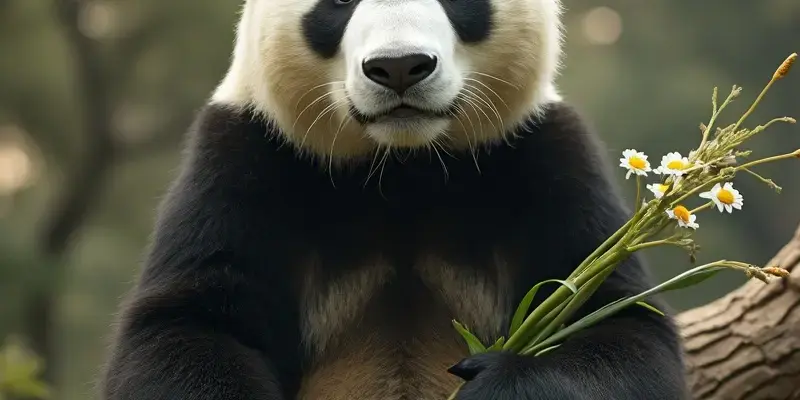Panda spiritual meaning

The gentle panda serves as a powerful spiritual guide embodying the profound principles of balance, harmony, and emotional sensitivity in Eastern wisdom traditions. Its iconic black and white markings visually represent the yin-yang philosophy, offering lessons in integrating opposing forces within ourselves while teaching the strength found in gentleness and self-acceptance.
Key Takeaways
- Pandas symbolize the perfect balance between opposing energies like strength and gentleness
- Their connection to the Heart Chakra represents emotional sensitivity and healthy boundaries
- Pandas are considered bearers of good fortune in many Eastern cultures
- Their conservation success story reflects spiritual resilience and perseverance
- Panda energy teaches quiet strength and mindfulness in our fast-paced world
The Symbolism of Balance and Duality
The panda’s striking black and white coloration serves as a living embodiment of the ancient yin-yang philosophy. This distinctive fur pattern isn’t merely decorative—it represents the fundamental duality that exists throughout nature and within ourselves. In Eastern wisdom traditions, pandas symbolize the harmonious integration of opposing forces: masculine and feminine energies, strength and gentleness, light and dark.
Chinese cultural symbolism has long recognized pandas as teachers of a profound truth: true power lies not in forceful assertion, but in serene self-acceptance. Unlike the aggressive bear relatives such as the black bear, pandas demonstrate that balance and harmony are the ultimate expressions of spiritual maturity. Their very existence challenges us to find equilibrium between contrasting aspects of our own nature.
Heart-Centered Energy and Emotional Sensitivity
When the panda appears as your spirit animal, it often signals a deep connection to Heart Chakra energy. These gentle creatures carry remarkable emotional sensitivity, making them highly attuned to their surroundings—a quality that brings both gifts and challenges. This sensitivity can sometimes lead to overwhelm when faced with environmental stressors, much like many empathic humans experience.
The panda mantra offers a powerful reminder: “Your feelings matter deeply. Don’t dismiss them.” Through their naturally solitary lifestyle, pandas teach us the importance of establishing healthy personal boundaries while still maintaining emotional openness. Their example offers practical guidance for those who feel easily drained by others’ energies.
For maintaining emotional balance during overwhelming situations, pandas suggest these strategies:
- Create dedicated quiet time for emotional processing
- Set clear boundaries with energy-draining relationships
- Connect with nature to reground your energy
- Practice heart-centered meditation focusing on self-compassion
- Balance periods of social engagement with solitary restoration
Conservation Success Story and Spiritual Resilience
The panda’s journey from endangerment to recovery offers a profound metaphor for spiritual resilience. Since the World Wildlife Fund adopted the panda as its logo in 1961, these remarkable creatures have demonstrated extraordinary perseverance. The 2016 status change from “Endangered” to “Vulnerable” marks a significant milestone in their conservation story.
Population data reveals this impressive comeback. The 2014 census counted 1,864 wild pandas, representing a 17% increase over the previous decade. Today, there are approximately 2,657 total pandas worldwide. Conservation efforts have expanded dramatically, growing from just 13 reserves in 1998 to 67 national reserves that now protect nearly 54% of panda habitats. The Giant Panda National Park alone houses over 1,800 individuals, about 80% of China’s panda population.
From a spiritual perspective, pandas’ 20-million-year existence on Earth connects to timeless messages of hope and persistence. Like their red panda cousins who’ve faced similar challenges, they remind us that even when faced with seemingly impossible odds, gentle determination can overcome tremendous obstacles.
Bearer of Good Fortune and Positive Omens
Across Eastern traditions, pandas hold a special place as symbols of good luck and positive omens. Unlike many animals that carry mixed or cautionary associations, pandas are remarkably free of negative symbolism in cultural traditions. Their appearance in dreams or as synchronistic encounters is often interpreted as a sign of forthcoming good fortune.
Pandas frequently appear as spiritual guides during periods of transition and emotional growth. Their comforting presence serves as a reminder of universal support during uncertain times. In Eastern cultures, pandas are regarded with special reverence as bearers of peace, luck and protective energy that helps shield against negative influences.
This spiritual significance extends beyond superstition into practical life guidance. The panda’s appearance in your consciousness might suggest:
- An upcoming period of positive change
- Reassurance during times of uncertainty
- Confirmation you’re on the right path
- An invitation to embrace balance in challenging situations
- A reminder that gentleness can be your greatest strength
Life Lessons from the Bamboo Forest
The panda’s daily existence in bamboo forests offers practical wisdom for our own lives. Their specialized diet and methodical approach to feeding demonstrates the power of finding your unique nourishment and consuming it with complete presence. This represents a striking contrast to the hurried, distracted eating patterns many humans have developed.
Pandas teach us the art of slowing down with calm determination to reach our goals. Despite their large size and physical power, they move with intentional grace, never rushing but always making steady progress. This approach offers a refreshing alternative to our culture’s obsession with speed and aggressive achievement.
Perhaps the most touching lesson from pandas is self-compassion—treating ourselves with the same tenderness we would offer a loved one. Their gentle self-care practices remind us that nurturing ourselves isn’t selfish but essential for sustainable living. Like the polar bear who must care for itself in harsh conditions, pandas show that self-nurturing is a form of wisdom, not indulgence.
Environmental stewardship emerges naturally from the panda’s harmonious relationship with its habitat. They take only what they need and live in balance with their surroundings, offering a model for sustainable human existence. Their childlike wonder and playfulness, even as adults, reminds us to see possibilities in each new day rather than becoming cynical or rigid in our thinking.
The Calming Power Animal
As a power animal, the panda offers specific healing properties, particularly for the Heart Chakra. Working with panda energy activates pathways to deeper self-love and emotional balance. During times of emotional stress, invoking the panda’s calm presence can provide immediate relief from anxiety and overwhelm.
A simple technique for connecting with panda energy involves visualizing yourself surrounded by their peaceful presence while breathing deeply. This practice helps activate the same grounding qualities that pandas naturally embody. Their earth-connected energy provides stability during chaotic times.
Panda symbolism inspires a particular form of gratitude practice: acknowledging that gratitude fills your heart with good feelings, just as bamboo nourishes the panda. This simple but powerful practice involves:
- Setting aside time each morning to list three things you appreciate
- Noticing small moments of beauty throughout your day
- Expressing gratitude for challenges that promote growth
- Acknowledging the support systems that sustain you
- Appreciating your own body and its remarkable functions
Modern Relevance: Quiet Strength in a Loud World
In today’s culture that often prizes aggression and constant productivity, the panda represents a revolutionary concept: sensitivity is not weakness but a form of intelligence. Their quiet strength offers an alternative model of power that doesn’t rely on dominance or force but on inner stability and peaceful presence.
Pandas demonstrate how to find your personal rhythm in a world obsessed with speed. They remind us that each being has its own natural pace and forcing ourselves to match arbitrary external standards often leads to burnout and disconnection. The panda’s unhurried existence serves as a powerful metaphor for hidden strength and quiet resilience.
Just as the panda embarks on a journey of renewal with each dawn, we too can approach each day with fresh perspective. Their wisdom applies directly to contemporary challenges of overstimulation and burnout by showing us that stepping back and creating space isn’t laziness—it’s essential self-preservation.
Panda energy teaches us to value our sensitive nature rather than seeing it as a liability. In a world filled with noise and constant demands, cultivating this quiet strength might be the most radical act of self-care—and ultimately, the path to sustainable fulfillment and authentic connection with both ourselves and the world around us.
The article explores the panda as a spiritual symbol representing balance, harmony, and emotional sensitivity in Eastern wisdom traditions. Their black and white markings visually represent yin-yang philosophy, teaching integration of opposing forces within ourselves. Pandas connect to the Heart Chakra, symbolizing emotional awareness and healthy boundaries. They’re considered bearers of good fortune in Eastern cultures and demonstrate spiritual resilience through their conservation success story. Their gentle nature teaches quiet strength and mindfulness in our fast-paced world.
| Key Aspect | Spiritual Significance |
|---|---|
| Black & White Coloration | Living embodiment of yin-yang philosophy; balance between opposing forces |
| Heart Chakra Connection | Emotional sensitivity, healthy boundaries, and self-compassion |
| Conservation Journey | Metaphor for persistence, hope, and overcoming obstacles |
| Eastern Symbolism | Bearer of good fortune, peace, and positive omens |
| Modern Relevance | Model of quiet strength and mindfulness in a loud, fast-paced world |














